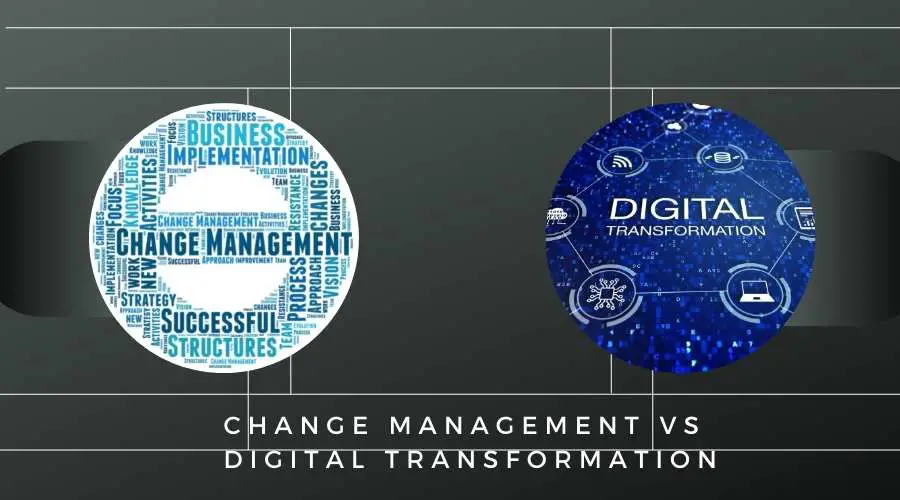Someone recently asked me, what’s the difference between change management and digital transformation?
It’s a great question because there seems to be a lot of confusion around these terms. In fact, many people use them interchangeably.
Although they are closely linked in terms of how businesses must adapt to survive and thrive in the digital age, it’s worth taking a closer look at these differences to better understand how each concept can be applied to your business.
In this post, we’ll take a closer look at change management vs digital transformation, define both concepts, and outline the key differences for businesses and professionals.
What is Change Management?
Change management is the process of planning, implementing, and monitoring changes to a company’s products, services, or processes.
It includes the identification of the stakeholders involved, the assessment of the impact of the change, the development of a plan to ensure that the change is implemented smoothly, and the monitoring of progress to ensure that the objectives are met.
There are several definitions of organizational change management out there. But one I like in particular is this one from SHRM:
Change management is the systematic approach and application of knowledge, tools and resources to deal with change. It involves defining and adopting corporate strategies, structures, procedures and technologies to handle changes in external conditions and the business environment.
It’s a broader term that encompasses several parts of the business, including human resources, operations, and marketing.
What is Digital Transformation?
Digital transformation is the process of using digital technologies to create new or different business processes, products, or services.
It can also refer to the transformation of an organization’s culture and values to be more focused on digital technologies.
In other words, it’s about using technology to create value for your business.
This could be in the form of creating new revenue streams, improving customer experience, or increasing operational efficiency.
So, while digital transformation incorporates elements of change management, it goes beyond that. It’s about using digital technologies to fundamentally change how your business operates.
To better understand the differences of these two concepts, let’s look at some examples.
Change Management in Action
When we elaborate on conventional change management, there are a few fundamental components, including:
- Defining the change
- Planning the change
- Implementing the change
- Monitoring the change
Let’s say you want to roll out a new CRM system. The first step is to define the change. This means understanding why you’re making the change, what will be different after the change is made, and who will be affected by the change.
Next, you’ll need to develop a plan for how the change will be implemented. This includes deciding when and how the new system will be introduced, training employees on how to use it, and setting up processes for data migration.
Once the change is underway, it’s important to monitor progress to ensure that the objectives are being met. This includes tracking KPIs, such as employee adoption rates and customer satisfaction levels.
Digital Transformation in Action
Digital transformation, on the other hand, is about using technology to create value for your business. This could be in the form of creating new revenue streams or improving customer experience.
For example, a company might use digital technologies to develop a new online customer portal. This could include features such as live chat, self-service options, and personalized recommendations.
Another example of digital transformation is using data analytics to improve decision-making. This could involve tracking customer behavior data and using it to inform marketing and product development strategies.
Also, business model transformation is a common goal of digital transformation initiatives. This could involve moving from a product-based business to a subscription-based model or developing new ways to monetize data.
In each of these examples, technology is being used to create new value for the business. But the focus is on using digital technologies, rather than on managing the change itself.
Key Differences Between Change Management and Digital Transformation

Now that we’ve looked at some examples of each concept, let’s compare and contrast the key differences.
- Change management is about managing the change itself, while digital transformation is about using technology to create value for your business.
- Change management is typically used for incremental changes, while digital transformation is often associated with radical changes.
- Change management is focused on the present, while digital transformation looks to the future. In this sense, change management is more reactive, while digital transformation is a more proactive process.
- Change management typically follows a linear process, while digital transformation can be more iterative and flexible.
- Change management is typically designed to minimize risk, while digital transformation is often about taking risks.
So, while both concepts involve change, they have different objectives. Change management is focused on managing the change process itself, while digital transformation is about using technology to create value for the business.
Digital transformation can be a daunting task for businesses and organizations.
But with a clear understanding of the concept, and a solid plan in place, it can be a powerful tool for driving growth and competitive advantage.



